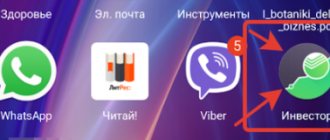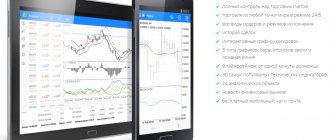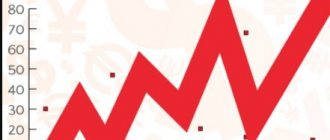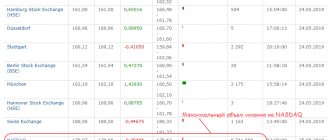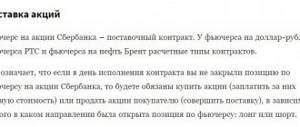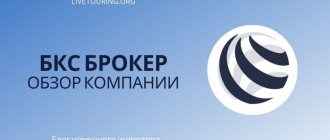Those who decide to try trading in the stock market need to master the software. The stock exchange is no longer that huge hall with a bunch of people holding corded telephones. With the development of technology and the massive spread of the Internet, trading has become available to everyone, but for this you need to learn how to use a special program. the Quik trading terminal is , how to download for free and get a demo account, and also consider the main features, because at first glance it may seem that it is simply impossible to understand anything there.
From this article you will learn:
- Quik terminal - what is it and what is it for?
- Installing the Quik terminal
- Setting up QUIK
- Trading in the Quik terminal
- Conclusion
Getting started with QUIK
Registration and installation
We will work with software downloaded from the BCS website. A full review of the BCS broker was done earlier. When working on a real account, Kwik will be free. If your deposit is less than 30,000 rubles (300 rubles per month), the company provides demo access to it. A training account is sufficient for review.
Immediately after registration, you will receive a link to the terminal itself, keys and instructions for installing the software. The process is standard: run the .exe file, select the drive and folder where QUIK should be located.
Let's launch the terminal. The login and password are in the letter that contained a link to download Kwik for PC. For further work, you need to copy the public key file (pubring.txk) key ; we previously downloaded them from the link in the letter. If it is not there, you will see a message like:
Also, when logging in, you need to specify the server from which the terminal will receive data. Everything here is similar to MetaTrader - for training accounts we select the appropriate servers.
If the keys are in the required folder, a connection to the server occurs. We receive a message about this. A notification may appear indicating that some of the instruments will soon expire. The terminal can replace them automatically, but this can also be done manually later.
Immediately after launch, the workspace will look like this:
If you are not working with BCS, the appearance of the terminal after launch may be different. It depends on the broker and software version.
Menu
Let's briefly go through the main functionality:
- System . These are the main parameters of the terminal. Here you make settings, order data, select the server type if necessary.
- Create a window . We will study this menu below when setting up workspaces. The menu is used to display information on transactions and add new windows.
- Actions . Here you can edit tables and place requests for opening positions. You will also find a set of filters here.
- Broker . Here the KVIK terminal allows you to set limits on the derivatives market, cash, and securities. They can also be saved to a file or uploaded to the platform.
- Extensions . Necessary for creating volatility charts and your own strategy (which is also loaded from a previously created template).
- Services . Through this menu we have access to Lua and QPILE scripts, and general filters are also located here. You can also set a criterion for automatically canceling orders when certain conditions are met.
- Window . Configuring the arrangement of windows in the workspace. There are several preset layouts.
For greater clarity, let’s delete all windows open after starting the terminal and add everything necessary for trading shares and OFZs.
Features of the service and operating mode
The KVIC platform from Sberbank allows traders to work with assets of the Moscow Stock Exchange and Interbank Currency Exchange and provides margin trading. The service allows you to use a special system installed on a personal computer or mobile device.
Internet trading is carried out through trading systems:
- Sberbank Investor;
- PC program QUIK;
- in the browser;
- mobile app.
The development of the KVIC platform belongs to professional traders and programmers. The flexibility of the system allows you to fine-tune trading conditions in accordance with the rules.
The QUIK system allows you to receive information from several sectors, and when using the main mode:
- constructing tables and graphs for selecting securities;
- tracking your own portfolio and account balances;
- making transactions;
- viewing quotes;
- placing pending orders, applications;
- import and export of operations performed by other systems;
- study current quotes and news;
- initiation of conditional requests;
- use of advisors;
- automatic write-off of commissions and tax payments;
- margin trading;
Exchange instruments are grouped into classes, for example, level 1 shares, Moscow Exchange indices, level 1 bonds. Each class contains a list of instruments characterizing the course of trading and corresponding to the listing of the selected sector. Filters are used to exclude parameters and select items.
Setting up the QUIK terminal
Unlike MetaTrader, where everyone’s workspace looks approximately the same, in Kwik it is advisable to customize it to your needs. For comfortable work, we need information on the instruments you work with, account status, created orders and concluded transactions.
Setting up the QUIK terminal begins with removing all the tabs at the bottom. There is only one left, we can’t do this with the last one, so we just close all the windows on it.
To add a new tab, select the appropriate item in the context menu and enter its name.
Adding information on promotions
We need to add an information window in which we will display data on the securities that interest us. For this:
- Go to the menu Create window – Current auctions.
- In the new menu that opens, we are interested in the Available tools .
- In it we look for the item MB FR T+ Shares (MB is the Moscow Exchange, and T+ denotes the trading mode).
- We open the list, it contains a list of papers, some of them need to be added to the Row headers .
- Select the instrument of interest and click Add . You can select several positions at once while holding Ctrl. Another option is to add the entire list at once, but it will be inconvenient to work with. You can also enter the name of the company in the field with a magnifying glass icon and you will see its shares in the drop-down menu of the search results. Let's form a pool of 10 papers.
- Now you need to choose what indicators the trading platform will display for these instruments. moving from the Available parameters Column Headings such items as lot, price of the last transaction and percentage of change from closing. If desired, add a short name of the security and turnover in money (these columns are optional). You can simply do everything as shown in the picture below.
The result will look like this:
The table dimensions can be changed , so there will be no problems with setting up the workspace.
Settings for bonds (OFZ)
Now let's move on to working with bonds and start from the same stage as in the case of stocks - from creating a table.
Technically, OFZs could have been included in the list of required instruments at the previous stage, but different parameters will be needed for OFZs and shares. The QUIK program does not allow displaying different characteristics of instruments within one table. We do the same as when adding shares, only now in the Available instruments window we select OFZs and transfer them to Row Headers. As for the parameters that need to be included in the column headings of the future table, I recommend setting:
- Percentage change from close;
- Coupon size , date of its payment and ACI (accumulated income);
- Duration – shows when you can return your investment. For Russian OFZs it is calculated in days, in the rest of the world in years;
- Yield by estimate.
As in the previous case, you can simply copy the main points from the picture above. And this is what the table itself looks like. We have added all the OFZs that the QUIK trading terminal offered, so there are a lot of lines.
In tables, you can sort tools in ascending and descending order . To do this, right-click anywhere in the column of interest, and the Sort .
You can also set conditions by which tools in tables should be filtered. For this:
- You need to highlight the name of the table column . Two icons will appear next to its designation, the last one is responsible for formatting, and in front of it is a funnel symbol. Click on it and you will be taken to the filter settings menu;
- Now you can set the limit values of the selected parameter . The table will display only instruments falling within the specified range.
The work on the Stocks + OFZ tab is completed.
State of an account
In this tab we need information on the client portfolio, limits on securities and funds.
To add matching elements:
- Go to the menu Create window – All types ;
- In the table that appears, from the Accounts and Positions , select the first three items.
As a result, you should get three windows, their presence is mandatory. You can also add a table with transactions here. We have a QUIK demo open and there is no trading yet, that’s why the last window is empty.
Setting up the display of orders and deals
This is the last tab and you only need to put two tables in it. One will display created orders, and the second will display transactions. They can be added to the previous tab, where we placed the client portfolio and limits, but during active trading it will be inconvenient to work with a large number of tables . Therefore, I still recommend dividing this information into three tabs.
They have not shown any activity yet, so there is no data on transactions and applications. This concludes the initial setup of the terminal .
How to save your settings
Quick has the ability to save workspace settings . Then this file can be loaded into the platform on any other PC and get the same picture as on the main computer. This saves a lot of time. A similar opportunity is available in other terminals. For example, in MT4 and MT5 it is possible to save chart templates and profiles, the essence is the same - in a separate file we get all the previously specified settings. Recently, an educational program was published on how to use the MetaTrader 5 terminal; it describes in more detail the basics of working with the trading platform. If you plan to work in Forex, I recommend reading this material.
To save the settings in the System , select the appropriate item and get a file with the extension .wnd . Save it, it is your workspace.
How to install Quik (Quik) Sberbank on a computer
Sberbank offers three options for installing the Kwik trading terminal on a computer for trading on the stock exchange:
- Connecting Quik with two-factor authentication using login and password
- Quik connection with KA authentication (USB token)
- Connecting Quik with two-factor key authentication (RSA)
In my opinion, the easiest and fastest way is to connect using the first option with two-factor authentication using login and password. Above, I showed how to download a distribution kit with the Kwik program from the official Sberbank website. Now open this downloaded file by double clicking the mouse. And in the archived file that opens, open the file with a white and blue rectangular icon and the inscription “quik_8.3.exe”.
Important! The numbers 8.3 will change. These indicate the version of Quik you are installing. This version will constantly change upward: 8.4,...9.1, etc.
The Installation Wizard window will appear. Click the “Next” button.
Select the first authentication type and go “Next”.
By default, the Setup Wizard suggests saving the Quik folder on drive C. We agree and move on.
To make opening Quik easier, create a shortcut.
Be sure to create a program icon for quick use on the desktop.
And we start the installation process on your computer on disk C with the “Install” button.
After a few seconds, the installation will be completed. Let's launch Kwik to work.
The main Kwik window will open. There will be one solid gray field and a warning window will automatically pop up. Click the “Ok” button.
Now here is the most important part for you: you need to enter your Username and Password.
Important! The username is the same as your brokerage account number.
For me it consists of 7 characters: three numbers + 4 letters. You don't have a password yet.
Important! The password for logging into Sberbank Investor will not work for logging into Quik Sberbank.
To get a password, you need to click on the phrase “Get password”. It is located under the password input field, is blue and underlined.
After clicking on the “Get password” command, a window will appear where you must enter the number of the Sberbank brokerage service agreement and check the box next to the phrase “I am familiar with the procedure for obtaining a password.” And click the “Submit” button.
Successful submission of the application is confirmed by a counter letter from the system with the following content:
A message from number 900 will be sent to your phone with a temporary password for logging into Kwik. Now you enter the following data into the login window:
- Username is your brokerage number
- The password is a temporary password sent from the 900 number to your phone.
After successfully entering all the numbers and symbols of the password correctly, the system will prompt you to change the password to yours.
Important! you must come up with your own password, which only you and no one else will know.
To do this, in the “You need to change the initial password” window, click the “Ok” button.
Now get your pen and notepad ready. And write down this password in a safe place. You will use it every day from now on. In the change password window you must enter:
- The password that the system sent you from the 900 number to your phone.
- Create your own password. (If it is too simple, the system will give you recommendations on how to complicate it.
- Repeat your created password, duplicating it in the “Password Confirmation” column.
All entered passwords will initially be encrypted with black circles to prevent intruders. Suddenly you don’t have an antivirus program on your computer and you often surf the Internet.
Important! If you don’t have an antivirus program, install it immediately. Working with money requires special security measures. And an antivirus program is a must for any PC user.
If the system is satisfied with the complexity of your password and you have entered and duplicated everything correctly, then the following window will appear in front of you, in which you need to enter a PIN code automatically sent to your phone from number 900.
Enter the PIN code from your phone. A window will appear confirming that two-factor authentication was successful.
Now you go to the “System” tab, go to “Establish a connection” and enter in the password window:
- Your Sberbank brokerage account number
- A new password, created by you and confirmed by two-factor authentication.
The long-awaited activated Quik will appear with tabs and windows already configured by default. Below is the “Trade” tab.
By default, everything is configured quite well. In principle, you can leave everything as it is, just adjust what you will use more actively. And so the following tabs are configured by default, except for the “Portfolio” tab (screenshot above):
Charts tab
Tab "Forex market".
"Future Market" tab.
“Algo orders” tab.
"Alerts" tab.
Well, the “News” tab is still present. I would delete the last three tabs: News, algorithmic requests, alerts. You can definitely do without them.
Order book in QUIK
MT5 also has this tool, but it is not particularly useful, since Forex is a decentralized market . The glass in this case does not provide significant information.
In the case of Quick, the situation is different: the work here is carried out with stock market instruments, so from the glass you can understand which levels may become significant in the future . It also gives an idea of where it is better to place limit orders to enter the market. This may well be the basis of a trading strategy. The site has an article about resistance and support levels, in which the use of these tools is discussed in more detail.
The order book shows the volumes that traders are going to buy or sell at different price levels. When the exchange is not working, you will not see this information; the table will be empty.
A glass in QUIK is opened by double-clicking the left mouse button on the desired instrument. It opens in a separate table. At the time of preparation of the material, trading on the MB had already ended, so we will include in the list of previously added shares an instrument from the currency section of the exchange (editing the table is opened with the combination Ctrl + E ).
Sell orders are marked in red ; for each the price level and the corresponding volume are indicated. Green is used for opposing orders. The glass is useful in several cases:
- When you want to determine the position of the levels;
- To determine the price at which it makes sense to place orders to enter the market;
- To estimate the spread.
A small example of analysis from the figure above:
- Liquidity is low , the so-called thin glass ;
- The spread is currently small, within 2% ;
- Growth above 114.0-116.0 is fraught with difficulties, large volumes were placed there for sale;
- The nearest tangible support is at 70.0.
You need to understand how orders will be executed when trading. Imagine that in the current situation you want to sell 30 lots. The deal will be concluded, but not at the price of 103.5. Instead, you will select all liquidity at levels from 103.5 to 70.0 until the required volume is collected by counter orders from buyers. In reality, you will not receive a significant amount.
If you have just started learning how to work in the stock market, I recommend paying special attention to the glass. Unlike Forex, this tool is very informative.
general information
Quik is a program that allows you to generate orders for the purchase and sale of exchange assets. This is a trading terminal through which the client communicates with the broker. With Quik, a user can:
- view the amount of money and securities in the portfolio;
- create applications of various types, monitor their status;
- to make deals;
- build charts of any complexity;
- use technical analysis tools;
- find out trading volume;
- export data;
- study current quotes and news.
How to make deals in Kwik
As in MetaTrader, you can work here not only on the market, but also with pending orders. To conclude a transaction, press F2 in the menu that appears:
- Instrument – an order is placed for this asset;
- Trading account – if there are several of them open, you can choose which one to trade from;
- The price at which the application will be added to the general list is set The closer it is to the current one, the faster it will be fulfilled. There is a complete analogy with MetaTrader and its limit and stop orders;
- The number of lots you are going to buy or sell. Conveniently, the number of securities in the lot is immediately displayed above the corresponding field;
- The commission and position value in money automatically calculated
All you have to do is click Yes and the application will be sent to the glass. If the execution price was not set too far from the market price, and the security is sufficiently liquid, the order is executed quickly. In our case, trading is not particularly active, so not a single deal has been concluded.
You can make sure that everything is in order with the application in the corresponding table. Opposite it appears the inscription “Active” . When the chart reaches the desired price, it will change to “Executed” , and a new line will appear in the window with transactions.
To cancel orders and close positions in the market, you will need a book of orders for the corresponding instrument. Call the context menu in it and through it delete orders to buy/sell securities and already open positions.
The only drawback of this approach is that it is inconvenient to work with a large number of applications . Especially if you need to quickly close them. You will have to open a glass for each instrument and cancel orders through it.
How to set up a stock (futures) chart
You cannot trade on the stock exchange without a chart. This is a separate, extensive topic that includes a number of important parameters, including volatility, time frames, and gaps.
However, for the purposes of this article, we must plot a chart of the stock we want to buy. The task is to experience the whole process as a trader. In the “Current table of parameters” window, you need to right-click the pop-up menu and select “Price and Volume Charts”.
In the Sberbank stock chart window that appears, you need to slightly change the default settings:
- Remove grid from screen
- Set up highlighting of lows and highs when you click on a candle
- Remove the unnecessary “Volumes” window for now.
- Set up timeframes
In addition, I recommend setting up a couple more windows this way:
- 60 minute chart
- 5 minute chart
All these recommendations are configured by right-clicking and selecting "Edit" from the menu.
Flexible work with orders, stop loss and take profit in Kwik
MetaTrader5 has several types of orders, for example, stop limit, buy limit and others. Work with applications to enter the market is organized quite flexibly. In this area, Kwik does not lag behind MT5. Above we looked at the option of simply deleting an application, but this is not the only thing that can be done with it.
In the context menu, through which we previously deleted unnecessary orders and closed transactions, there are two more items:
- Replace application . If it has not yet been executed, you can edit its parameters;
- Iceberg application . It differs from the usual one in that it allows you to hide information on the number of securities being purchased from other trading participants. A new item appears in the market entry order settings : Visible quantity . Here you indicate the number of shares that will be displayed in the order book. The rest will become invisible to traders, but the order will be executed in full.
This type of applications received its name by analogy with ordinary icebergs. Most of this ice block remains invisible, hidden under water. The same goes for your order; only the broker will know the full volume .
Let's move on to whether there is a stop order in the QUIK terminal; we'll also figure out how to set a take profit. In trading I recommend using both. The exception is traders with experience and the ability to monitor the status of open positions throughout the trading session.
Stop-Loss in QUIK
If you have worked in MetaTrader before, there may be a little confusion. In Kwik there is no traditional Stop Loss , its role is played by an order of the Stop Limit . This is explained as follows (using the example of a transaction to purchase Aeroflot shares at a price of 91.12 in 3 lots):
- For her, SL is a sell order placed below the market price. But in Quick you cannot place a simple limit of this type: it will be executed immediately according to the market since this number is more profitable than the one you set in the settings.
- To place SL through the order book, select New stop order and set the stop limit in it. The validity period can be set. Before cancellation, the type of instrument is automatically selected to the one on which the transaction is opened.
- Since we have a long position open, in the Activation Conditions the Sell type .
- Now we set the price level, upon reaching which our stop loss will be set. From the terminal’s point of view, this will be an order to open a short position on the same instrument with the same volume with which it was previously entered into a long position. In the stop limit field, if price <=, set a value, for example, 90.00.
- Next, another price is set - an order to sell shares will be placed at it. The value can be anything, the main thing is that it is not higher than that specified in the previous paragraph. Even if we set the value to 88.00, the terminal will still execute the order at the most favorable price, close to or equal to 90.00.
Take-Profit in QUIK
The same technique is used when setting take profit. Moreover, in Kwik it is implemented in such a way that it immediately acts as a trailing stop , allowing profits to accumulate on non-recoil movements. The procedure for setting take profit for the same example (Aeroflot shares, buying 3 lots at 91.12):
- In the left part of the window with parameters, indicate the price at which you would like to fix the profit (RUB 100.00 per share). Don't forget to set the same volume as the previously opened buy trade;
- Let's go to the right side of the window. Here you need to set the offset from the maximum and the protective spread ; they can be specified both in the deposit currency and as a percentage. Let's assume they are equal to 2 and 1 ruble.
Events will develop like this. When the price reaches the level of 100.00 rub. for a share the position is not closed. Instead, the terminal begins to measure the magnitude of the downward rollback. If we go down a distance equal to the distance from the maximum (2 rubles), then at the distance of the protective spread a sell order will be placed, that is, it will be located at a price of 97.00 rubles. in our example.
With a recoilless movement, profits will accumulate . If the chart reaches a level, for example, 105.00 and only then a correction begins, the position will be closed at a price of 103.00.
It sounds a little confusing, so I recommend that you immediately practice using different types of applications. Then the question of how to work with them will disappear by itself.
Program functionality
The software application connects to the Quik system server of a specific brokerage company and in real time:
- provides access to market information;
- allows you to take part in trading operations.
Thanks to the system, a trader seeking to extract the greatest profit directly from the process of trading securities receives the following services:
- monitoring of current quotes for exchange instruments, allowing traders to quickly assess the current situation on the market;
- control over the state of one’s own financial portfolio, that is, over the totality of investments;
- placing orders: exchange, limit, conditional;
- execution of purchase and sale transactions;
- carrying out trading operations with assets received from a broker on credit;
- placing pending orders - orders that will be executed in the future when the price reaches the value specified in the order;
- tracking the dynamics of trading in company shares on charts;
- setting up SMS notifications that allow you to receive information about necessary operations;
- communication with customer support and provision of financial advice;
Working with charts
To build it, you need to select the appropriate item in the context menu.
By default, it is plotted in the form of Japanese candlesticks . In addition, options are available in the form of a line, bars, histogram, and dotted line. Fans of graphical analysis will not find anything new here. Through the context menu – Draw, you can use standard tools (trend line, horizontal and Fibo levels).
To add an indicator, click on Insert or select the corresponding icon on the toolbar. These are mainly standard algorithms; approximately the same set is available in MetaTrader and other trading platforms.
One of the features of QUIK is the ability to obtain horizontal volumes . Standard indicators are not capable of this, but there are several good LUA algorithms on the Internet; you need to install them in the terminal and then add the indicator to the chart.
LuaIndicators folder in the directory where QUIK is located and copy the downloaded file there. The terminal does not need to be rebooted; a custom tool should appear in the list of indicators. The figure above shows one of these custom algorithms.
Functional
The front office system remembers the user's settings and reproduces them in subsequent sessions, even if the terminal is logged in from another computer. A lightweight version of the program, adapted for smartphones and tablets, allows you to use the terminal from mobile devices connected to the Internet.
WebQUIK functionality from Sberbank 6.6.1:
- View quotes online
- Access to the market book
- View current and completed orders
- Viewing information about completed transactions
- Conducting transactions on the exchange
- Submitting limit, market and conditional orders
- View information about the current portfolio status
- Plotting charts using technical analysis indicators
Kwik for mobile devices
Even models in the mid-price segment cope with Kwik without any problems. The developer has released versions for Android and iOS devices; functionally they are no different.
Let's look at the basics of working with the terminal at the BCS broker. It is not enough to simply download the QUIK terminal on Android and log in to it. Through your personal account, you submit an order to connect a new trading terminal and only then receive a login and password for it. I provide a link to detailed instructions from BKS for installing and configuring Kwik here .
As for the functionality itself, it is somewhat poorer compared to the desktop version. For example, you cannot set your own indicators. And in general, working on devices with a small diagonal is uncomfortable. Through your mobile device you can:
- Work with charts and preset indicators;
- Submit the same types of requests as in the desktop version;
- Get information about your portfolio, limits;
- There is a full glass;
- View details of transactions, applications;
- Receive news.
In general, the functionality is similar to the PC version. So the main limiter in the case of working via a smartphone is the diagonal of its screen, and not the capabilities of the terminal. It is simply inconvenient to trade on a 5-6 inch display . I recommend considering this version of the platform as an addition, the ability to monitor transactions even when you are on the go or simply cannot work through a laptop or regular PC.
Advantages and disadvantages of the trading platform
Even inexperienced traders can use the Kwik service with minimal knowledge and skills, thanks to:
- modular design of the program - everyone has the right to adapt the interface to their needs;
- security of transactions - protection of personal and financial data is ensured by unique cryptographic software;
- the ability to withdraw money from Quick Sberbank to any payment instrument opened in Sberbank;
- detailed and simple instructions that are freely available;
- competent and prompt information and technical support.
Experienced traders and experts point out that the main disadvantage is the large commissions written off for brokerage operations. And the fact that the program has a standard appearance and a large number of settings causes dissatisfaction only at the time of familiarization.
Terms and Definitions
Below are a number of specific symbols that you may encounter when working in Kwik and in the stock market in general:
- Application – agreement to buy/sell an asset at a certain price;
- Client portfolio – a table that displays the client’s account status. In particular, details of margin lending, volume of funds;
- Limit – how much funds are available for concluding transactions on the market;
- A portfolio is a specific type of table; in Kwik they are filled out using the QPILE programming language;
- Spread is the difference between the best buyer and seller prices, respectively;
- Ticker – a code indicating a specific type of asset;
- QPILE is the programming language used in Kwik;
- Short and long – sell and buy transactions, respectively;
- Trading session – a period of time during which work is carried out;
- Price step is the minimum possible change in the value of an asset.
You can find out more about the terms in the Glossary in the QUIK Help.
Demo account (briefly)
For virtual trading, which is carried out for the purpose of training and familiarization with the system, funds are allocated to the user. An open demo account allows you to work with the QUIK application. Compared to the formation of quotes on the stock exchange, in the educational version the chart is formed with a delay of 10 minutes.
Consideration of applications to buy or sell an option lasts 1 business day. The distribution of educational information is carried out on the basis of an agreement with the Moscow Exchange, so users have the opportunity to connect to trading using major financial instruments.
The system functionality is expanded on a modular basis using additional services. Novice traders can build charts, maintain quotes outside the trading session, and connect a quote generation module.
The service administrator software is at the disposal of the broker, who registers new users, determines the settings and their rights. The functionality of the application is limited to the basic configuration, so the quotes for the demo version differ from the actual ones.
The educational application limits the use of complex modules, financial instruments, and analysis of the current balance. The demo version is available for use for 1 month, so there is no access to viewing transactions for the previous period.
Hot keys and their combinations
As in MT5, in Quick you can simplify your work by using buttons that duplicate certain commands:
- F1 – help;
- F2 – enter an application;
- F4 – creating a quote window;
- F6 – stop order;
- F7 – create a new window;
- F9 – setting up a client place;
- Insert – adding an indicator to the chart;
- Shift+Alt+Del – window for canceling orders by condition;
- Ctrl+A – its replacement;
- Ctrl+D – remove it;
- Ctrl+K – close the deal;
- Ctrl+I – revolution;
- Ctrl+Z – closes the purchase;
- Ctrl+X – removes a short position;
- Ctrl+E – editing the table;
- Ctrl+N – copy it.
There are several dozen key combinations in total; the most common ones are listed above. Ctrl+H button combination opens an editor in which you can assign your own buttons and their combinations to any of the above actions.
Sberbank Quik support service and possible problems
Each user can send comments and suggestions regarding work and maintenance by email to [email protected] ru. And also send your wishes by message from the “Technical Support” page on the official website of the developer.
You can get answers to questions regarding working with trading systems by calling (support service hours are 9:00 - 21:00 Moscow time).
When using the program you may encounter the following problems:
- problems when entering a name and password (for example, “The file with the keys was not found”, “Encryption error N...”);
- problems establishing a connection with the server (for example, “Connection could not be established”, “No Route to Host”);
- errors when working with the program (for example, Connection timed out, “It is impossible to write connection settings to the info.ini settings file”).
You should also contact the Service Administrator if you receive the following system messages:
- the instrument limit is not set;
- the user's money limit is not set;
- the user does not have rights to work on this trading account.
Difference between QUIK functionality and MT5
There is an opinion that Kwik is the choice of professionals, and MetaTrader is more of a pampering game and you can’t make serious money with it. A controversial statement, since both platforms have their merits.
Through Kwik you can work on the stock, derivatives and foreign exchange markets. There is an options board and generally maximum analytical information. Having a full glass in both desktop and mobile versions is worth a lot. There are no obstacles to automating trade and developing your own ATS.
On the other hand, MT5 is more user-friendly, information on commissions is visible, as is the trading history. It is much more convenient to test robots.
If we compare both terminals according to a number of criteria, we get the following picture (the winner is indicated on the right side):
- Support from brokers – QUIK ;
- Interface and ease of use - MT5 ;
- Usage fee – QUIK ;
- Availability of statistics on trading history, commissions - MT5 ;
- Work speed – MT5 ;
- Ease of creating and testing robots - MT5 .
As you can see, MT5 is at least no worse than Kwik . In the past, indeed, QUIK was practically the only solution for working on the stock market, but since then the situation has changed. Trading on Kwik is still considered prestigious, but those who tried MT5 did not have any special complaints about it.
What is a demo account?
Demo is of course a shortened name. And it does not reflect the importance of this opportunity. If I give you the essence in other words, you get something like this:
A demo is your personal virtual, demo account on an exchange with a limited usage limit.
The broker allows you to trade various stocks, bonds, futures and options completely free of charge for several months in a real combat terminal of a professional trader.
The broker gives you virtual money into your account, thereby completely making you a real trader.
Using this money, you buy or sell assets. You can keep trade statistics, plan operations, and earn money. There is no difference with real trading.
The only difference is that the money is not real and you cannot withdraw it or cash it.
The purpose of a demo account is to demonstrate to you how thousands of other investors trade real money on the stock exchange.
And you can repeat all the same actions of other traders, but for now with virtual money.
Important! There is no need to invest your money here. All operations are virtual, toy, unreal.
And it’s a great opportunity for you to feel everything from the inside.
All major brokers have this service. If you have not yet chosen a broker, I advise you to read my analysis of brokers. In the meantime, let's see what some of the brokers offer us in the form of trading demos for beginners. And yes! I almost forgot:
Important! For all beginners, I recommend starting trading with the Quik program.
There are a number of other trading programs, but most traders choose Quik. A fairly simple and functional trading program.
So, let's look at demo versions of several brokers. They will not be particularly different, because they all have the same Quik-Junior program.


